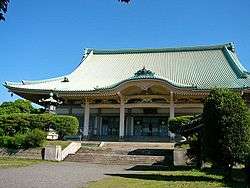Buddhist temples in Japan
Buddhist temples are, together with Shinto shrines, considered to be among the most numerous, famous, and important religious buildings in Japan.[note 1] The Japanese word for a Buddhist temple is tera (寺), and the same kanji also has the pronunciation ji, so that temple names frequently end in -dera or -ji. Another ending, -in (院), is normally used to refer to minor temples. Such famous temples as Kiyomizu-dera, Enryaku-ji, and Kōtoku-in illustrate this naming pattern.
Buddhist and Shinto structures

In Japan, Buddhist temples co-exist with Shinto shrines, and both share the basic features of Japanese traditional architecture.[1] Not only can torii, the gates usually associated only with Shinto, be found at both, but the entrance to a shrine can be marked by a rōmon, a gate which is Buddhist in origin and can therefore very often be found also at temples. Some shrines, for example Iwashimizu Hachiman-gū, have a Buddhist-style main gate called sōmon. Many temples have a temizuya and komainu, like a shrine. Conversely, some shrines make use of incense or have a shōrō belltower. Others – for example, Tanzan Jinja in Nara – may even have a pagoda.[2]
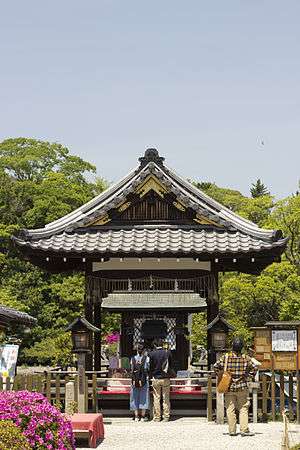
Similarities between temples and shrines are also functional. Like a shrine, a Buddhist temple is not primarily a place of worship: its most important buildings are used for the safekeeping of sacred objects (the honzon, equivalent to a shrine's shintai), and are not accessible to worshipers.[1] Unlike a Christian church, a temple is also a monastery. There are specialized buildings for certain rites, but these are usually open only to a limited number of participants. Religious mass gatherings do not take place with regularity as with Christian religions, and are in any event not held inside the temple. If many people are involved in a ceremony, it will assume a festive character and will be held outdoors.[1]
The reason for the great structural resemblances between the two lies in their common history. It is in fact normal for a temple to have been also a shrine, and in architectural terms, obvious differences between the two are therefore few, so much so that often only a specialist can see them.[1]
Shrines enshrining local kami existed long before the arrival of Buddhism, but they consisted either of demarcated land areas without any building or of temporary shrines, erected when needed.[3] With the arrival of Buddhism in Japan in the 8th century, shrines were subjected to its influence and adopted both the concept of permanent structures and the architecture of Buddhist temples.[3]

The successive development of shinbutsu-shūgō (syncretism of Buddhism and kami worship) and of the honji suijaku theory brought to the almost complete fusion of kami worship and Buddhism.[4] It became normal for shrines to be accompanied by temples in mixed complexes called jingū-ji (神宮寺 lit. shrine temple) or miyadera (宮寺 lit. shrine temple).[note 2] The opposite was also common: most temples had at least a small shrine dedicated to its tutelary kami, and were therefore called jisha (寺社 temple shrines). The Meiji era's eliminated most jingūji, but left jisha intact, so much so that even today most temples have at least one, sometimes very large, shrine on their premises and Buddhist goddess Benzaiten is often worshiped at Shinto shrines.[note 3][5]
As a consequence, for centuries shrines and temples had a symbiotic relationship where each influenced the other. Shrines took from Buddhism its gates (Mon), the use of a hall for lay worshipers, the use of vermilion-colored wood and more, while Chinese Buddhist architecture was adapted to Japanese tastes with more asymmetrical layouts, greater use of natural materials, and an adaptation of the monastery to the pre-existing natural environment.[6]
The clear separation between Buddhist temples and Shinto shrines, which today is the norm, emerges only as a result of the shinbutsu bunri ("separation of kami and Buddhas") law of 1868. This separation was mandated by law, and many shrine-temples were forced to become just shrines, among them famous ones like Usa Hachiman-gū and Tsurugaoka Hachiman-gū.
Because mixing the two religions was now forbidden, jingūji had to give away some of their properties or dismantle some of their buildings, thus damaging the integrity of their cultural heritage and decreasing the historical and economic value of their properties.[7] For example, Tsurugaoka Hachiman-gū's giant Niō (the two wooden wardens usually found at the sides of a temple's entrance), being objects of Buddhist worship and therefore illegal where they were, were sold to Jufuku-ji, where they still are.[8] The shrine-temple also had to destroy Buddhism-related buildings, for example its tahōtō, its midō, and its shichidō garan.[7]
Architecture
General features
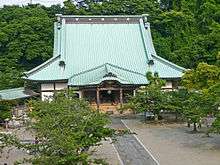
Buddhist architecture in Japan is not native, but was imported from China and other Asian cultures over the centuries with such constancy that the building styles of all Six Dynasties are represented. Its history is as a consequence dominated by Chinese and other Asian techniques and styles (present even in Ise Shrine, held to be the quintessence of Japanese architecture) on one side, and by Japanese original variations on those themes on the other.[9]
Partly due also to the variety of climates in Japan and the millennium encompassed between the first cultural import and the last, the result is extremely heterogeneous, but several practically universal features can nonetheless be found. First of all is the choice of materials, always wood in various forms (planks, straw, tree bark, etc.) for almost all structures. Unlike both Western and some Chinese architecture, the use of stone is avoided except for certain specific uses, for example temple podia and pagoda foundations.[9]
The general structure is almost always the same: post and lintel support a large and gently curved roof, while the walls are paper-thin, often movable and in any case non-carrying. Arches and barrel roofs are completely absent. Gable and eave curves are gentler than in China and columnar entasis (convexity at the center) limited.[9]
The roof is the most visually impressive component, often constituting half the size of the whole edifice.[9] The slightly curved eaves extend far beyond the walls, covering verandas, and their weight must therefore be supported by complex bracket systems called tokyō. These oversize eaves give the interior a characteristic dimness, which contributes to the temple's atmosphere. The interior of the building normally consists of a single room at the center called moya, from which sometimes depart other less important spaces, for example corridors called hisashi.
Inner space divisions are fluid, and room size can be modified through the use of screens or movable paper walls. The large, single space offered by the main hall can therefore be altered according to the need.[9] The separation between inside and outside is itself in some measure not absolute as entire walls can be removed, opening the temple to visitors. Verandas appear to be part of the building to an outsider, but part of the external world to those in the temple. Structures are therefore made to a certain extent part of their environment. The use of construction modules keeps proportions between different parts of the edifice constant, preserving its overall harmony.[9](On the subject of temple proportions, see also the article ken).
Even in cases as that of Nikkō Tōshō-gū, where every available space is heavily decorated, ornamentation tends to follow, and therefore emphasize rather than hide, basic structures.[9]
Being shared by both sacred and profane architecture, these architectonic features made it easy converting a lay building into a temple. This happened for example at Hōryū-ji, where a noblewoman's mansion was transformed into a religious building.
History
The architecture of Buddhist temples, as that of any structure, has changed and developed over the centuries. However, while the particular details may vary, the general themes and styles have strong similarities and common origins.
The already mentioned Hōryū-ji was one of the first Buddhist temples built in Japan. Its primary structures represent the style current in 6th century Sui dynasty China. The Kondō (Golden Hall) is a double-roofed structure, supported by thick, strong pillars, and giving a feeling of boldness and weight.
Most Buddhist temples in Japan belong to one of four main styles:
- Wayō - A style developed in art and architecture in Japan during the Heian period by the esoteric sects Tendai and Shingon on the basis of contemporary Chinese architecture. So called to distinguish it from imported Chinese styles, in architecture it was characterized by simplicity, refrain for ornamentation, use of natural timber and in general plain materials.
- Daibutsuyō - a Japanese religious architectural style which emerged in the late 12th or early 13th century on the basis of contemporary Chinese architecture. Introduced by priest Chōgen, this grandiose and monumental style was based on Song Dynasty architecture and was the antithesis of the simple and traditional wayō style. The Nandaimon at Tōdai-ji and the Amida Hall at Jōdo-ji are the only extant examples of this style.[10][11]
- Zenshūyō - A style which takes its name from its creator, the Buddhist Zen sect, and which emerged in the late 12th or early 13th century on the basis of contemporary Chinese architecture. The zenshūyō was originally called karayō (唐様 Chinese style) but, like the Daibutsu style, was rechristened by Ōta Hirotarō, a 20th-century scholar. Its characteristics are earthen floors, decorative curved pent roofs (mokoshi) and pronouncedly curved main roofs, cusped windows (katōmado) and paneled doors.[10][12] Typical of the style is also the main hall (Butsuden), which has just one story but seems to have two because of the presence of a covered pent roof called mokoshi.
- Setchūyō - an architectural style born in Japan during the Muromachi period from the fusion of elements from three preceding styles, the wayō, the daibutsuyō and zen'yō. It is exemplified by the main hall at Kakurin-ji.[12][13] The combination of wayō and daibutsuyō in particular became so frequent that sometimes it is classed separately by scholars under the name Shin-wayō (新和様 new wayō).[12]
Layout and geomantic positioning
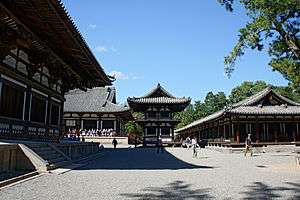
Buddhist temple complexes consist of a number of structures arranged according to certain concepts or guidelines.
The arrangement of the major buildings (garan haichi (伽藍配置)) changed over time. An early pattern had a gate, tower, kondō and kodō in a straight line from south to north. Corridors extended east and west from the flanks of the gate, then turned north, and finally joined north of the kōdo, forming a cloister around the pagoda and the major halls. This pattern, typified by Shitennō-ji in Osaka, came from China via Baekje; the Chinese style of Buddhist temples, though altered somewhat by China via Korean peninsula, ultimately was based on that of Chinese palaces, and this is evident in many of the basic design features which remain today in the temples of all three countries.
A Buddhist temple complex in Japan generally follows the pattern of a series of sacred spaces encircling a courtyard, and entered via a set of gates. These gates will typically have a pair of large guardian statues, called Niō.
In addition, many of the more important or powerful temples are built in locations which are favorable according to the precepts of Chinese geomancy. For example, Enryaku-ji, which sits atop Mount Hiei to the north-east of Kyoto, is said to defend the city from evil spirits by being placed in that direction. The arrangements of mountains and other geographic features in particular directions around the temple play important roles as well. This custom continued for a long time. Eight centuries after the founding of Enryaku-ji, the Tokugawa shogunate established Kan'ei-ji in a similar direction for the protection of their Edo Castle. Its mountain-name, Mount Tōei (東叡山 Tōei-zan), takes a character from Mount Hiei (比叡山 Hiei-zan), and can be interpreted as meaning "the Mount Hiei of the East."
Kamakura's Tsurugaoka Hachiman-gū is now only a Shinto shrine but, before the Shinto and Buddhism Separation Order (神仏判然令) of 1868, its name was Tsurugaoka Hachiman-gū-ji (鶴岡八幡宮寺 Tsurugaoka Hachiman Shrine Temple) and it was also a Buddhist temple, one of the oldest of the city.[14] The temple and the city were built with Feng Shui in mind.[15] The present location was carefully chosen as the most propitious after consulting a diviner because it had a mountain to the north (the Hokuzan (北山)), a river to the east (the Namerikawa) and a great road to the west (the Kotō Kaidō (古東街道)), and was open to the south (on Sagami Bay).[15] Each direction was protected by a god: Genbu guarded the north, Seiryū the east, Byakko the west and Suzaku the south.[15] The willows near the ponds and the catalpas next to the Museum of Modern Art represent respectively Seiryū and Byakko.[15]
Geomancy lost in importance during the Heian period as temple layout was adapted to the natural environment, disregarding fengshui.
In addition to geomantic considerations, Buddhist temples, like any other religious structures, need to be organized in order to best serve their various purposes. The most important space in any Buddhist temple complex is the sacred space where images of Buddhas and bodhisattvas are kept, and where important rituals are performed.
These areas are always separated from those accessible to the lay worshipers, though the distance between the two and the manner of their separation is quite varied. In many temples, there is little more than a wooden railing dividing the sacred space with that of the laypeople, but in many others there is a significant distance, perhaps a graveled courtyard, between the two.
Another structure or space of great importance accommodates the physical day-to-day needs of the clergy. Spaces for eating, sleeping and studying are essential, particularly in those temples that serve as monasteries.
According to a 13th-century text,[16] "a garan is a temple with a kon-dō (main hall), a tō (pagoda), a kō-dō (lecture hall), a shōrō (belfry), a jiki-dō (refectory), a sōbō (monks' living quarters), and a kyōzō (scriptures deposit, library)."[17] These are the seven listed as shichidō elements of a Nanto Rokushū (南都六宗 Nara six sects)[18] temple.[19]
A 15th-century text[20] describes how Zen school temples (Sōtō (曹洞), Rinzai (臨済))[21] included a butsuden or butsu-dō (main hall), a hattō (lecture hall), a kuin (kitchen/office), a sō-dō (building dedicated to Zazen), a sanmon (main gate), a tōsu (toilet) and a yokushitsu (bath).
Common temple features
- Butsuden or Butsu-dō (仏殿・仏堂) – lit. "Hall of Buddha".
- A Zen temple's main hall. Seems to have two stories, but has in fact only one and measures either 3×3 or 5×5 bays.
- Any building enshrining the statue of Buddha or of a bodhisattva and dedicated to prayer.[19]
- chinjusha (鎮守社/鎮主社) – a small shrine built at a Buddhist temple and dedicated to its tutelary kami.[19]
- chōzuya (手水舎) – see temizuya.
- chūmon (中門) – in a temple, the gate after the naindaimon connected to a kairō.[19] See also mon.
- dō (堂) – Lit. hall. Suffix for the name of the buildings part of a temple. The prefix can be the name of a deity associated with it (e.g. Yakushi-dō, or Yakushi hall) or express the building's function within the temple's compound (e.g. hon-dō, or main hall). See also Butsu-dō, hō-dō, hon-dō, jiki-dō, kaisan-dō, kō-dō, kon-dō, kyō-dō, mandara-dō, miei-dō, mi-dō, sō-dō, Yakushi-dō and zen-dō.
- garan – see shichi-dō garan.
- hattō (法堂) – lit. "Dharma hall". A building dedicated to lectures by the chief priest on Buddhism's scriptures (the hō).[19]
- hōjō (方丈) – the living quarters of the head priest of a Zen temple.[22]
- Hokke-dō (法華堂) – lit. "Lotus Sūtra hall". In Tendai Buddhism, a hall whose layout allows walking around a statue for meditation.[22] The purpose of walking is to concentrate on the Hokekyō and seek the ultimate truth.[22]
- honbō (本坊) – residence of the jushoku, or head priest, of a temple.[22]
- kairō (回廊・廻廊) – a long and roofed portico-like passage connecting two buildings.[22]
- kaisan-dō (開山堂) – founder's hall, usually at a Zen temple. Building enshrining a statue, portrait or memorial tablet of the founder of either the temple or the sect it belongs to. Jōdo sect temples often call it miei-dō.[22]
- karamon (唐門) – generic term for a gate with an arched roof.[22] See also mon.
- karesansui (枯山水) – lit. dry landscape. A Japanese rock garden, often present in Zen temples, and sometimes found in temples of other sects too.
- katōmado (華頭窓) – a bell shaped window originally developed at Zen temples in China, but widely used by other Buddhist sects as well as in lay buildings.
- kon-dō (金堂) – lit. "golden hall", it is the main hall of a garan, housing the main object of worship.[22] Unlike a butsuden, it is a true two-story building (although the second story may sometimes be missing) measuring 9×7 bays.[22]
- konrō (軒廊) – covered corridor between two buildings
- korō or kurō (鼓楼) – tower housing a drum that marks the passing of time. It used to face the shōrō and lie next to the kō-dō, but now the drum is usually kept in the rōmon.[19]
- kuin* (庫院) – kitchen/office of a Zen garan. A building hosting the galleys, the kitchen, and the offices of a temple.[19] Usually situated in front and to the side of the butsuden, facing the sō-dō. Also called kuri.
- kuri (庫裏) – see kuin
- kyō-dō (経堂) – see kyōzō.
- kyōzō (経蔵) – lit. "scriptures deposit". Repository of sūtras and books about the temple's history.[22] Also called kyō–dō.
- miei-dō (御影堂) – lit. "image hall". Building housing an image of the temple's founder, equivalent to a Zen sect's kaisan-dō.[22]
- mi-dō (御堂) – a generic honorific term for a building which enshrines a sacred statue.[22]
- Miroku Nyorai (弥勒如来) – Japanese name of Maitreya.
- mon (門) – a temple's gate, which can be named after its position (nandaimon: lit. "great southern gate"), its structure (nijūmon: "two storied gate"), a deity (Niōmon: lit. "Nio gate"), or its use (onarimon: lit. "imperial visit gate", a gate reserved to the Emperor). The same gate can therefore be described using more than one term. For example, a Niōmon can at the same time be a nijūmon.
- nandaimon (南大門) – the main southern gate of a temple, in particular that at Nara's Tōdai-ji.[22] See also mon.
- nijūmon (二重門) – a two-storied gate with a roof surrounding the first floor.[22] See also mon.
- Niōmon (仁王門 or 二王門) – a two-storied or high gate guarded by two wooden guardians called Niō.[22] See also mon.
- noborirō (登廊) – a covered stairway at Nara's Hase-dera.
- pagoda – see stupa and tō.
- rōmon (楼門) - a high gate with two floors, only one of which has usable space, surrounded by a balcony and topped by a roof.[22] Buddhist in origin, it is used also in Shinto shrines.[23]
- sai-dō (斎堂) – the refectory at a Zen temple or monastery.[19] See also jiki-dō.
- sandō (参道)- the approach leading from a torii to a shrine. The term is also used sometimes at Buddhist temples too.
- sanmon (三門 or 山門) – the gate in front of the butsuden.[22] The name is short for Sangedatsumon (三解脱門), lit. Gate of the three liberations.[22] Its three openings (kūmon (空門), musōmon (無相門) and muganmon (無願門)) symbolize the three gates to enlightenment.[22] Entering, one can free himself from three passions (貪 ton, or greed, 瞋 shin, or hatred, and 癡 chi, or "foolishness"). See also mon. Its size depends on the temple's rank. (See photos.)
- sanrō (山廊) – small buildings at the ends of a two-storied Zen gate containing the stairs to the second story.
- sekitō (石塔) – a stone pagoda (stupa).[19] See also tō
- shichidō garan (七堂伽藍) – a double compound term literally meaning "seven halls" (七堂) and "(temple) buildings" (伽藍). What is counted in the group of seven buildings, or shichidō, can vary greatly from temple to temple and from school to school. In practice, shichidō garan can also mean simply a large complex.
- shoin (書院) – originally a study and a place for lectures on the sutra within a temple, later the term came to mean just a study.[19]
- shōrō (鐘楼) – a temple's belfry, a building from which a bell is hung.
- sōbō (僧坊) – The monks' living quarters in a non-Zen garan
- sō-dō (僧堂) – Lit. "monk hall". A building dedicated to the practice of Zazen.[19] It used to be dedicated to all kinds of activities, from eating to sleeping, centered on zazen.
- sōmon (総門) – the gate at the entrance of a temple.[19] It precedes the bigger and more important sanmon. See also mon.
- sōrin (相輪) – a spire reaching up from the center of the roof of some temple halls, tiered like a pagoda.
- sotoba or sotōba (卒塔婆) – transliteration of the Sanskrit stupa.
- A pagoda. Tower with an odd number of tiers (three, five, seven nine, or thirteen). See also stupa.
- Strips of wood left behind tombs during annual ceremonies (tsuizen) symbolizing a stupa.[19] The upper part is segmented like a pagoda and carries Sanskrit inscriptions, sutras, and the kaimyō (posthumous name) of the deceased.
In present-day Japanese, sotoba usually has the latter meaning.
- stupa – in origin a vessel for Buddha's relics, later also a receptacle for scriptures and other relics. Its shape changed in the Far East under the influence of the Chinese watchtower to form tower-like structures like the Tōbuttō, the gorintō, the hōkyōintō, the sekitō, the tō, or the much simpler wooden stick-style sotoba.[22]
- tatchū (塔頭 or 塔中)
- tahōtō (多宝塔) – a two-storied pagoda with a ground floor having a dome-shaped ceiling and a square pent roof, a round second floor and square roofs.[22]
- temizuya (手水舎) – a fountain near the entrance of a shrine and a temple where worshipers can cleanse their hands and mouths before worship.[22]
- tesaki (手先) – Term used to count the roof-supporting brackets (tokyō (斗きょう)) projecting from a temple's wall, usually composed of two steps (futatesaki (二手先))) or three (mitesaki 三津手先).[22]
- tokyō (斗きょう) – see tesaki.
- torii (鳥居)- the iconic Shinto gate at the entrance of a sacred area, usually, but not always, a shrine. Shrines of various size can be found next to, or inside temples.
- tōrō (灯籠) – a lantern at a shrine or Buddhist temple. Some of its forms are influenced by the gorintō.
- -tō (塔)
- A pagoda, and an evolution of the stupa. After reaching China, the stupa evolved into a tower with an odd number of tiers (three, five, seven, nine, thirteen), excepted the tahōtō, which has two.[22]
- The word is used together as a suffix of a numeral indicating the number of a pagoda's tiers (three tiers= san-jū-no-tō, five tiers= go-jū-no-tō, seven tiers = nana-jū-no-tō, etc.).
- tōsu or tōshi (東司) – a Zen monastery's toilet.[22]
- Yakushi-dō (薬師堂) – a building that enshrines a statue of Yakushi Nyorai.[22]*
- yokushitsu* (浴室) – a monastery's bathroom.[22]
- zen-dō (禅堂) – lit. "hall of Zen".[22] The building where monks practice zazen, and one of the main structures of a Zen garan.[22]
Temple names
A temple's name (jigō (寺号) or jimyō (寺名)) is usually made of three parts. The first is the sangō (山号 mountain name), the second is the ingō (院号 cloister name) and the third is the san'in-jigō (山院寺号 temple name).[24]
Sangō
Even though they may be located at the bottom of a valley, temples are metaphorically called mountains and even the numbers used to count them carry the ending -san or -zan (山), hence the name sangō. This tradition goes back to the times when temples were primarily monasteries purposely built in remote mountainous areas.[24] The founding of a temple is called kaisan (開山 lit. opening of the mountain) for this reason.
No fixed rules for its formation exist, but the sangō is basically topographical in origin,[24] as in Hieizan Enryaku-ji: these two names together mean "Mount Hiei's Enryaku-ji". For this reason it is sometimes used as a personal name, particularly in Zen. There may be however some other semantic relationship between the sangō and the san'in-jigō, as for example in the case of Rurikōzan Yakushi-ji. The sangō and the jigō are simply different names of the same god.[24] Sometimes the sangō and the jigō are both posthumous names, for example of the founder's mother and father.
Ingō
The character in (院), which gives the ingō its name, originally indicated an enclosure or section and therefore, by analogy, it later came to mean a cloister in a monastery.[24] It is in this sense which it is applied to temples or, more often, subtemples. It can be also found in the name of formerly minor temples risen by chance to great prominence. For example, Kawagoe's Kita-in used to be one of three subtemples of a temple which no longer exist. Less frequent in an ingō are -an (庵 hermitage) and -bō (坊 monk's living quarters). -dō (堂 hall) is normally used in the name of particular buildings of a temple's compound, e.g. Kannon-dō, but can be employed as a name of minor or small temples.[24]
Jigō
The only name in common use is however the jigō, (ending in -ji, -tera, -dera (〜寺, ... temple)) which can then be considered the main one.[24] The sangō and ingō are not, and never were, in common use. The character -ji it contains is sometimes pronounced tera or dera as in Kiyomizu-dera, normally when the rest of the name is an indigenous name (kun'yomi).[24]
Unofficial names
Temples are sometimes known by an unofficial but popular name. This is usually topographical in origin, as for example in the case of Asakusa's Sensō-ji, also known as Asakusa-dera. A temple can also be named after a special or famous characteristic, as for example in the case Kyoto's Saihō-ji, commonly called Koke-dera, or "moss temple" because of its famous moss garden. Unofficial names can have various other origins.
Gallery
- Kōzan-ji's Butsuden in Shimonoseki
 Motoyama-ji's chinjū-dō
Motoyama-ji's chinjū-dō Kōmyō-ji's chinjūsha
Kōmyō-ji's chinjūsha Chūmon at Hōryū-ji
Chūmon at Hōryū-ji Myōshin-ji's hattō
Myōshin-ji's hattō Tōdai-ji's Hokke-dō
Tōdai-ji's Hokke-dō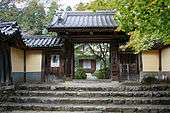 Jingo-ji's honbō
Jingo-ji's honbō Tōfuku-ji's hon-dō
Tōfuku-ji's hon-dō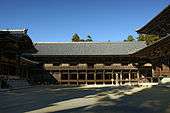 Engyō-ji's jiki-dō
Engyō-ji's jiki-dō Yakushi-ji's kairō
Yakushi-ji's kairō Tōfuku-ji's kaisan-dō
Tōfuku-ji's kaisan-dō Hōgon-ji's karamon
Hōgon-ji's karamon Shitennō-ji's karesansui
Shitennō-ji's karesansui A katōmado
A katōmado Tōfuku-ji's sanmon is 5 ken wide.
Tōfuku-ji's sanmon is 5 ken wide. Kō-dō at Tōshōdai-ji
Kō-dō at Tōshōdai-ji Kon-dō at Tōshōdai-ji
Kon-dō at Tōshōdai-ji A konrō
A konrō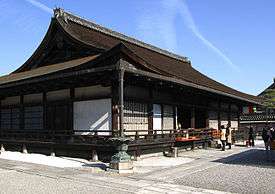 Miei-dō at Tō-ji
Miei-dō at Tō-ji Nandaimon at Hōryū-ji
Nandaimon at Hōryū-ji The noborirō at Nara's Hase-dera
The noborirō at Nara's Hase-dera- Nijūmon at Kōmyō-ji in Ayabe.
 A niōmon
A niōmon (East) Pagoda at Yakushi-ji in Nara
(East) Pagoda at Yakushi-ji in Nara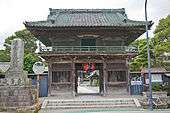 A rōmon
A rōmon- Kiyomizu-dera's sandō
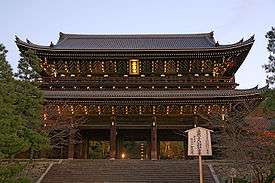 A high rank, five-bay sanmon at Chion-in. Note the sanrō.
A high rank, five-bay sanmon at Chion-in. Note the sanrō. A middle rank, three-bay sanmon at Myōtsū-ji
A middle rank, three-bay sanmon at Myōtsū-ji_sanmon.jpg) A low rank sanmon at Sozen-ji in Osaka
A low rank sanmon at Sozen-ji in Osaka The sanrō of Tōfuku-ji's sanmon. (See also the sanmon's photo above.)
The sanrō of Tōfuku-ji's sanmon. (See also the sanmon's photo above.) Zenrin-ji's sōmon
Zenrin-ji's sōmon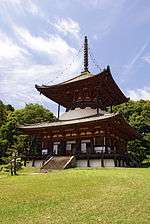 Negoro-ji's large sōrin (metal spire) on top of a daitō (large tahōtō)
Negoro-ji's large sōrin (metal spire) on top of a daitō (large tahōtō)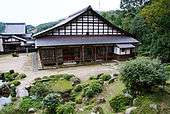 Saifuku-ji's shoin
Saifuku-ji's shoin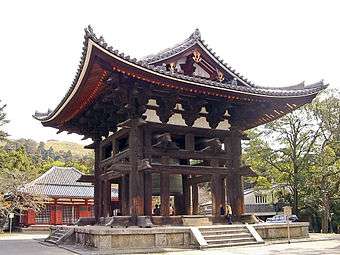 Tōdai-ji's shōrō (an early type)
Tōdai-ji's shōrō (an early type) Saidai-ji's shōrō (a later type)
Saidai-ji's shōrō (a later type)- Kongō Sanmai-in's tahōtō (nijū-no-tō)
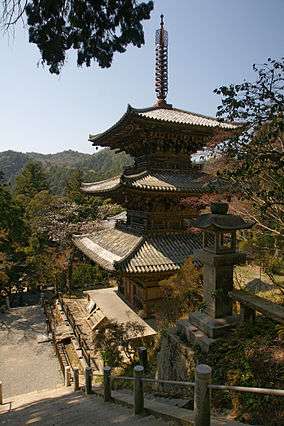 Ichijō-ji's three-tiered pagoda (sanjū-no-tō)
Ichijō-ji's three-tiered pagoda (sanjū-no-tō) Zentsū-ji's five-tiered pagoda (gojū-no-tō)
Zentsū-ji's five-tiered pagoda (gojū-no-tō) Mii-dera's temizuya
Mii-dera's temizuya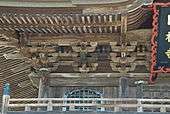 Brackets (tokyō, futatesaki in this case) under the eaves of a sanmon's roof.
Brackets (tokyō, futatesaki in this case) under the eaves of a sanmon's roof.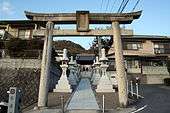 A torii on a temple's (Oyake-ji) sandō
A torii on a temple's (Oyake-ji) sandō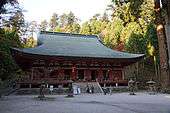 Enryaku-ji's shaka-dō
Enryaku-ji's shaka-dō- Tōfuku-ji's tōsu
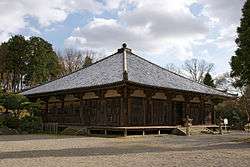 Jōdo-ji's yakushi-dō
Jōdo-ji's yakushi-dō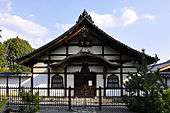 Myōshin-ji's yokushitsu (the temple's baths)
Myōshin-ji's yokushitsu (the temple's baths)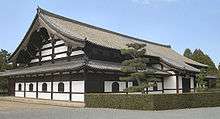 Tōfuku-ji's zen-dō
Tōfuku-ji's zen-dō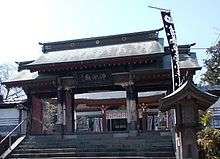 Gate at Jōchibyō, the grave of Katō Kiyomasa at Honmyō-ji, Kumamoto
Gate at Jōchibyō, the grave of Katō Kiyomasa at Honmyō-ji, Kumamoto Rakan-ji's Sanmon in Nakatsu
Rakan-ji's Sanmon in Nakatsu
See also
- Buddhism in Japan
- Buddhist art
- Buddhist architecture
- Glossary of Japanese Buddhism
- Japanese architecture
- List of Buddhist temples
- Terakoya
- List of National Treasures of Japan (temples)
- Senjafuda
- Tō
- Japanese art
Notes
- ↑ The term "Shinto shrine" is used in opposition to "Buddhist temple" to mirror in English the distinction made in Japanese between Shinto and Buddhist religious structures. In Japanese the first are called jinja (神社), the second tera (寺).
- ↑ The fact was reflected in their name. Kamakura's Tsurugaoka Hachiman-gū, for example, was then called Tsurugaoka Hachiman-gūji, or Tsurugaoka Shrine-temple.
- ↑ An extant example of the syncretic fusion of Buddhism and Shinto is Seiganto-ji, part of the Kumano Sanzan shrine complex. It is one of the few jingūji still in existence after the forcible separation of Shinto and Buddhism operated by the Japanese government during the Meiji restoration. For details of the subject of shrine-temples, see the article Shinbutsu shūgō.
- see the book Japanese temples:sculptures, paintings, gardens and architecture
References
- 1 2 3 4 Bernhard, Scheid. "Anleitung: Religiōse Bauten in Japan". Religion in Japan (in German). University of Vienna. Retrieved 17 October 2010.
- ↑ Fujita Masaya, Koga Shūsaku, ed. (April 10, 1990). Nihon Kenchiku-shi (in Japanese) (September 30, 2008 ed.). Shōwa-dō. p. 79. ISBN 4-8122-9805-9.
- 1 2 Fujita, Koga (2008:20-21)
- ↑ Scheid, Bernhard. "Shinto:Versuch einer Begriffbestimmung". Religion in Japan (in German). University of Vienna. Retrieved 17 October 2010.
- ↑ "Jingūji". Encyclopedia of Shinto. Retrieved 29 September 2010.
- ↑ Young & Young 2007, p=47
- 1 2 Kamakura Official Textbook for Culture and Tourism
- ↑ Mutsu (1995:172)
- 1 2 3 4 5 6 7 Hozumi (1996:9-11)
- 1 2 Fletcher & Cruickshank 1996, p=737
- ↑ Nishi & Hozumi 1996, p=20
- 1 2 3 Fletcher & Cruickshank 1996, p=738
- ↑ Young & Young 2007, p=44
- ↑ Kamakura Shōkō Kaigijo (2008: 56-57)
- 1 2 3 4 Ōnuki (2008:80)
- ↑ Shōtoku Taishi's Denkokonmokurokushō (聖徳太子伝古今目録抄)
- ↑ Kōsetsu Bukkyō Daijiten (広説仏教語大辞典)
- ↑ The six Buddhist schools 南都六宗, introduced to Japan during the Asuka and Nara periods
- 1 2 3 4 5 6 7 8 9 10 11 12 13 14 15 Iwanami Kōjien
- ↑ Sekiso Ōrai (尺素往来)
- ↑ The Obaku School (黃檗) arrived in Japan in the 17th century.
- 1 2 3 4 5 6 7 8 9 10 11 12 13 14 15 16 17 18 19 20 21 22 23 24 25 26 27 28 29 30 31 32 JAANUS
- ↑ Fujita & Koga 2008, pp. 84–85
- 1 2 3 4 5 6 7 8 Seckel, Dietrich (Winter 1985). "Buddhist Temple Names in Japan". Monumenta Nipponica. 40, N. 4: 359–386. JSTOR 2384822.
Bibliography
- Fletcher, Sir Banister; Cruickshank, Dan (1996) [1896]. Sir Banister Fletcher's a history of architecture (20th illustrated ed.). Architectural Press. ISBN 0-7506-2267-9. Retrieved 2009-11-11.
- Fujita Masaya, Koga Shūsaku, ed. (April 10, 1990). Nihon Kenchiku-shi (in Japanese) (September 30, 2008 ed.). Shōwa-dō. ISBN 4-8122-9805-9.
- Japanese Art Net User System Dictionary of Japanese Architectural and Art Historical Terminology (JAANUS)
- Kamakura Shōkō Kaigijo (2008). Kamakura Kankō Bunka Kentei Kōshiki Tekisutobukku (in Japanese). Kamakura: Kamakura Shunshūsha. ISBN 978-4-7740-0386-3.
- Mutsu, Iso (June 1995). "Jufuku-ji". Kamakura: Fact and Legend. Tokyo: Tuttle Publishing. ISBN 0-8048-1968-8.
- Nishi, Kazuo; Hozumi, Kazuo (1996) [1983]. What is Japanese architecture? (illustrated ed.). Kodansha International. ISBN 4-7700-1992-0. Retrieved 2009-11-11.
- Ōnuki, Akihiko (2008). Kamakura. Rekishi to Fushigi wo Aruku (in Japanese). Tokyo: Jitsugyō no Nihonsha. ISBN 978-4-408-59306-7.
- Sansom, George (1962). "Japan: A Short Cultural History." New York: Appleton-Century Crofts, Inc.
- Young, David; Young, Michiko (2007) [2004]. The art of Japanese architecture. Architecture and Interior Design (illustrated, revised ed.). Tuttle Publishing. ISBN 0-8048-3838-0. Retrieved 2009-11-11.
Further reading
- Cluzel, Jean-Sébastien (October 2008). Architecture éternelle du Japon - De l'histoire aux mythes. Dijon: Editions Faton. ISBN 978-2-87844-107-9.
External links
- Japanese Temples Guide to over 190 with pictures and map.
- Japanese temples of historical interest. With photos.
- Kyoto and Japanese Buddhism by Tokushi Yusho. Brief history of temples in Kyoto by a Japanese scholar (English Translation)
| Wikimedia Commons has media related to Buddhist temples in Japan. |
